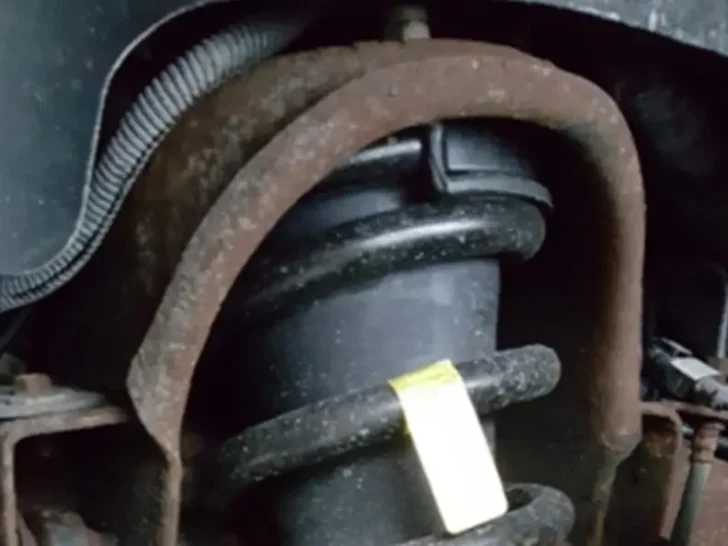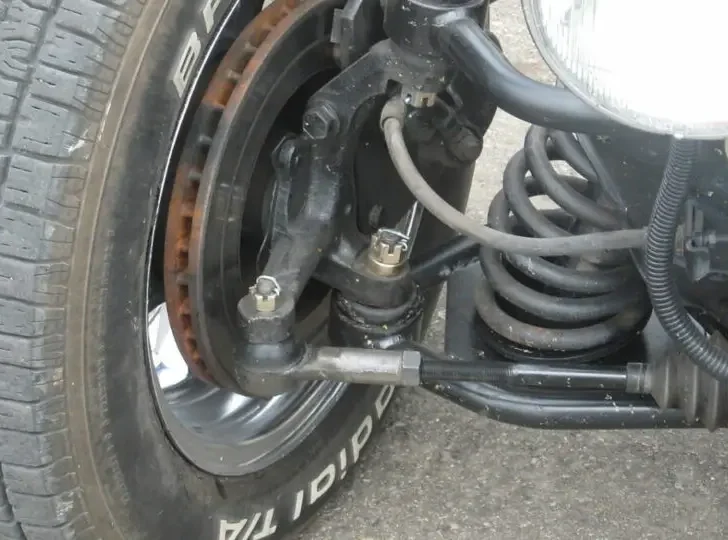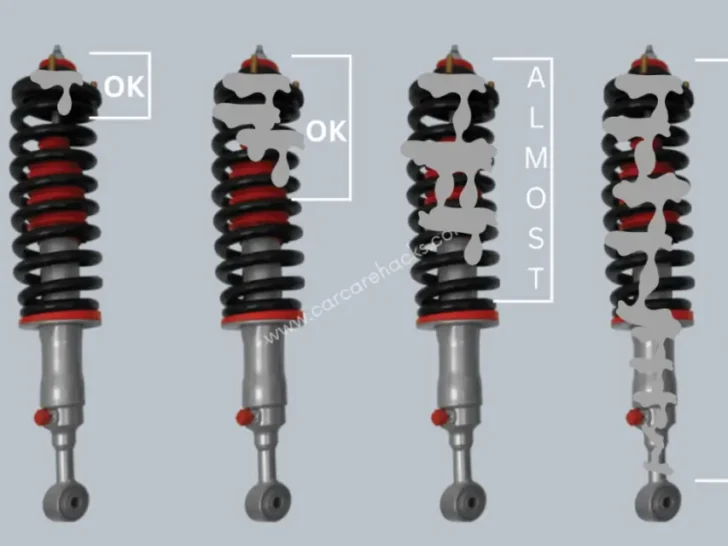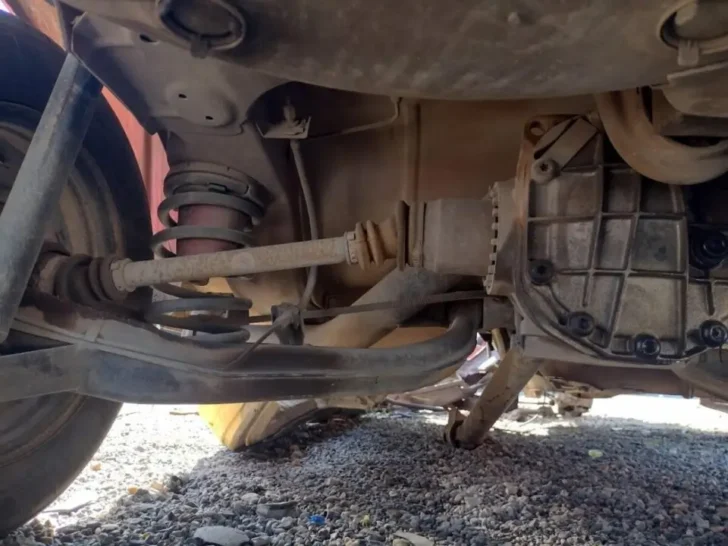When it comes to cars, struts are incredibly important components that help the vehicle’s suspension system absorb uneven surfaces on the road. Essentially, they work by taking the energy produced when the car hits a bump and transforming it into heat, which is dissipated as oil flows through small passages in the strut’s design. Since this oil helps mitigate the impacts of adverse riding conditions, can car struts leak?
Key Takeaway
- If the strut is bad, the hydraulic fluid found inside the strut can force oil to leak out of the strut when you go over a bump, pothole, or just general rough road conditions.
- To verify that a strut is leaking, it is best to perform a visual inspection. It is only acceptable if there is a little bit of oil on the top of the strut. However, if there is oil on the sides of the strut, it needs to be replaced.
- It is okay to drive with a leaky strut if the oil is only leaking at the top of the strut and not all over the place.
- You can drive for up to six months with leaky struts.
- A leaky strut will give a clinging or dangling noise when you go over a bump.
Can Car Struts Leak?

Yes, car struts can leak because they have pistons and hydraulic fluid in them. When a vehicle traverses over bumps, potholes, or rough road conditions, that piston is pushed against that hydraulic fluid that can force oil to leak out of the strut if the seal is bad.
A strut cycles billions of times as it goes down the road. Plus, some roads can be quite bumpy which only causes the strut to work even harder. Now, when you hit a pothole, the struts absorb this force and dampen the feeling thanks to the piston and hydraulic fluid inside. But, depending on how bad the force of the road is, it can cause the strut to leak oil because the top is not a complete seal.
A small oil leak on the side of the car struts is called weepage. This does not necessarily mean that the strut needs to be replaced. A small amount of leakage is acceptable and is the result of fluid clinging to the rod and being pulled past the oil seal on the extension stroke.
Monotube struts have a much higher internal gas pressure. That high internal gas pressure forces very minimal amounts of oil to weep through the micro-cracks of the chrome layer on the piston rod. That oil can get past the oiled silk and end up on the body of the strut.
A good rule of thumb is to replace your leaking car struts if the oil has made it past half of the body strut. You can also do a further inspection of the oil itself. If it appears as a thick coating with pieces of dust and debris in it, chances are the struts will need replacing.
How Do You Know If a Strut Is Leaking?

Struts are critical but often overlooked parts that help your vehicle drive off safely after hitting a bump on the road. Struts can get damaged by larger potholes, corrosion from road salt, or simply wear out from use. But, how exactly can you know if a strut is leaking?
The best way to tell if a strut is leaking is to visually inspect it. But keep in mind that it is considered normal for the strut to leak around the top and this strut doesn’t need replacing. However, if the strut has excessive oil all over the body, it is most likely that it has failed and needs replacing.
If your car becomes bouncier after hitting a bump, or the car nose dives when braking hard, there is a good chance that the struts are going bad. These two symptoms are enough for you to go ahead and perform a visual inspection of the struts.
Most vehicles on the road today use a strut-type suspension which is a coil spring placed around a shock absorber. The spring supports the weight of the car and allows the suspension to soak up rough roads. The spring also stores this energy as it’s compressed over a bump, and then releases it. When a strut starts leaking, your car would bounce uncontrollably as the spring compresses and releases this energy over and over again.
Is It OK To Drive With a Leaking Strut?

It is okay to drive with a leaking strut if the leakage is only minimum and is around the top of the strut. In fact, it is quite common for struts to leak around the top end because when a piston pushes the hydraulic fluid inside the strut, some of it can actually escape past the seal. It is not okay to drive with a leaking strut if the leakage is severe and the oil looks dirty and gunky.
Inside a car’s struts, a layer of oil serves as both a cushion and lubricant that is integral to keeping the ride smooth on bumpy roads. When shock absorbers encounter abrupt changes in movement, such as when going over speed bumps or potholes, the oil quickly moves from one chamber of the strut to another through small passages inside.
This quick transfer helps even out the shock for occupants in the car and prevents too much vibration from traveling through suspensions, axles, and other components. The oil also works to keep the parts within the strut moving rapidly and efficiently with minimal friction.
Inside the strut, there is a seal that keeps the oil from leaking. However, the struts go up and down thousands of times, the seal is going to wear out over time and oil can start to leak on the strut body. Sometimes the struts can get hit by a rock while driving which can damage the body and cause oil to leak out.
Inspecting a leaking strut to determine whether or not it is ok to drive includes removing the wheel, inspecting the clarity of the oil, and determining how bad the leakage is. If oil has leaked all the way to the bottom of the strut, it is probably a good idea to replace it.
Possible Safety Risks Involving Driving With a Leaking Strut
Driving a car with a leaky strut can pose significant safety hazards. Leaking struts cause the suspension system of the vehicle to lose pressure, potentially leading to decreased handling and stability – making it harder for drivers to accurately control their vehicle in unpredictable situations such as accidents.
Furthermore, if the strut is completely worn out or damaged, it could cause an abrupt change in ride height, further decreasing operability.
In addition to impeding your vehicle’s performance, a leaky strut may also cause premature tire wear due to increased pressure on certain parts of the tires when turning corners or traversing uneven terrain.
Tire failure at high speeds is especially hazardous, so it is essential that any leaky struts be addressed promptly.
Finally, a worn-out strut can damage other components of the vehicle’s suspension system such as control arm bushings or tie rods.
This will result in reduced handling and overall instability while driving, increasing the risk of an accident or injury.
Drivers must take all necessary precautions when dealing with a leaky strut. If you believe your vehicle may have one, it is recommended that you take it in for inspection and repair by an experienced technician immediately.
Delays in fixing issues related to struts or any other part of your car’s suspension system should never be delayed due to potential safety hazards they present.
How Long Can I Drive With a Leaking Strut?
How long you can drive with a leaking strut will depend on the severity of the leakage and how much the car is driven. If your struts are only starting to leak at the top, you can drive for up to six months. This type of leakage is actually considered normal.
However, if the leaking is severe and oil is dripping all the way to the bottom of the struts, it is time to replace them. Struts provide structural support to the vehicle, and comfort, but also keep your vehicle stable during cornering and braking.
On top of the struts, there is a seal that keeps the hydraulic fluid inside of the struts. However, this seal is not a complete seal. This is why it is normal for a strut to leak a little bit at the top. But, over time, this seal wears out completely and allows water and dirt to enter the hydraulic fluid and contaminate it. At this point, the struts aren’t doing what they are supposed to and it is time for a replacement.
Many car owners think that struts only provide comfort for the passengers by dampening the road effects. Struts actually keep the vehicle glued to the ground when cornering and braking. If your struts are bad, your vehicle could roll. Also, when you hit the brakes in an emergency situation and your struts are bad, this will cause the car to nose-dive and increase the stopping distance.
What Does a Leaking Strut Sound Like?

A leaking strut can give away a dinging, clanging, and rattling noise because the seal has failed and allowed water in which forced out the hydraulic fluid and the strut shaft is banging left and right inside the strut.
In general, struts consist of three main components: the coil spring that absorbs bumps in the road by helping to maintain tire contact, a structural arm known as the control arm that is located on either side of the suspension system and resists lateral forces, and a struts shock absorber that works with the spring to dampen energy inputs from the road’s surface.
On top of the strut, there is an oil seal. All car struts come with oil seals that help to keep lubricant in the strut while preventing dirt and debris from entering the chamber. However, when this seal fails, it will allow water and dirt to get inside which will cause the hydraulic fluid to leak out over time.
When the hydraulic fluid leaks out, the strut shaft will have no lubrication and you will hear a banging noise each time you drive over a bump or a pothole.
